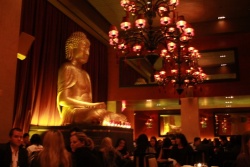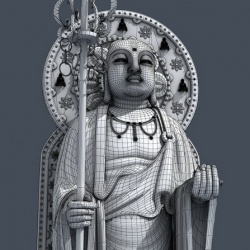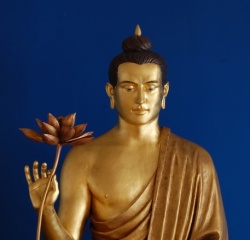Top 10 Unsolved Mysteries of Tibet
Long closed off and unreachable in its Himalayan fastness, Tibet, the Roof of the World, is always a mysterious land topping the wish list of worldwide travelers. Now it's open to the world. However, there are still too many Tibet mysteries waiting for Tibet travelers and scientists and scholars to explore. This page shows the top ten unsolved mysteries of Tibet.
1. Yeti Mystery
Yeti, the Tibetan name for Abominable Snowman, is an ape-like hairy, biped creature said to inhabit the Himalayan region of Tibet and Nepal. Many expeditions have been organized to track down the elusive Yeti, but none have found more than Yeti footprints and questionable artifacts like scalps and hides.
So far there is no firm evidence to support the existence of the Yeti, but there is no way show that he doesn't exist either. If he indeed lives in the barren, frozen, upper reaches of the Himalayas where few men dare to tread, he may find his refuge safe for a long time to come.
2. Gterma Mystery
Gterma is the re-excavated classics, hidden by Bon and Tibetan Buddhists when their religious beliefs were in catastrophe. Gterma includes possession of books, possession of sacred objects, and possession of knowledge.
The most magical part is the possession of knowledge. It refers to Gterma buried deep in people's consciousness. It is said that when a classic cannot be handed down in the event of a disaster, it can be granted by the gods to the depths of a person's consciousness to avoid being lost.
When condition allows, in some mysterious inspiration, the Buddhist scriptures were granted and can be written or recorded to the core, even by some illiterate farmers and herdsmen. This phenomenon is the mystery of Gterma (hidden Tibetan Buddhist scriptures).
3. Shambhala Mystery
Shambhala, also translated as Shangri-La, means "pure land" in Tibetan language. It is the myth of the Buddhist world and the birthplace of Kalachakra teachings. With regard to the existence of Shambhala, there has always been skepticism, and the Shambhala Buddhist scholars think that it is a fictional paradise. Tibetan historical books recorded in great detail the Shambhala. However, if Shambhala, exists or not, is still a mystery.
4. Mystery of Rainbow Body
Rainbow Body is a mysterious phenomenon of Tibetan Buddhism. A lama who has acquired the highest forms of accomplishment can manifest what is called "the rainbow body" or "body of light". It is said that the physical body of those who studied Buddhism very deeply will turn into a rainbow
5. Mystery of Storytellers of King Gesar
Life of King Gesar is a well-known Tibetan heroic epic and is the only living epic in the world today, which has been passed down mainly orally by folk artists. There are still more than 100 folk artists living in Tibet, Inner Mongolia and Qinghai provinces, and singing of the great achievement of the Tibetan hero King Gesar.
Among the many folk artists, those who can tell more than one version are claimed to be "divine artists", which means they are inspired by God. Most of the storytellers said that they were summoned by God or King Gesar in a dream, and then they began singing uncontrollably. In Tibet, some illiterate teenagers can suddenly tell the epic of King Gesar with more than one million words. This incredible phenomenon is yet unsolved.
6. Mystery of Shangshung Kingdom
The ancient Shangshung Kingdom created the earliest civilization of Tibet plateau. It not only invited its unique Shang Shung language, but also served as the birthplace of the Bon religion. The Shangshung Kingdom exerted profound influence on the culture of whole Tibet. However, its mysterious extinction has left many riddles that have not been solved through the ages.
7. Mystery of Guge Kingdom
In the mid-9th century, the Tubo Kingdom collapsed. The descendants established the Guge Kingdom and created a splendid civilization within 700 years. Later in 1630, Guge was overthrown by Ladakh. According to records, the slaughter and predation of the war was not enough to exterminate the Guge civilization. However, it just suddenly vanished like the ancient Mayan civilization.
Today, the ruins of the Guge Kingdom leave us some amazing architecture, ancient paintings, the mysterious Guge Silver Eye, and so on. But why Guge civilization vanished so suddenly and without a clue to trace is still a mystery.
8. Mystery of Tibetan Shaman
As the host of Tibetan primitive religious worship, Tibetan shamans are said to have the ability to communicate with God and can talk with spirits. Tibetan shaman also enter supernatural realms or dimensions to obtain solutions to problems afflicting the community, to bring guidance to misguided souls and to heal illnesses of the human soul caused by foreign elements. They are intermediaries or messengers between the human world and the spirit worlds.
They perform a variety of functions in the social life of Tibetan people: fortune-telling, healing, leading a sacrifice, preserving the tradition by songs and storytelling, guide of souls, etc. However, as time passes, we still know little about shamans - their costumes, heritage, religious objects, spells, altars, witchcraft, divination, etc
9. Mystery of Mount Everest Flag Clouds
When the weather is pleasant, one can always sees milky white flag-shaped clouds on the top of Mount Everest. Prevailing winds from the west blow the cloud east like a billowing flag attached to the mountain. Ascending airflow caused by the mountains creates the cloud. Blowing snow could also create the cloud.
The Mount Everest flag cloud posture is multifarious, looking like flags that flutter in the breeze sometimes, sometimes like a great wave; Turning into slender and graceful smoke at times. Because the change of the flag cloud can reflect the change in the high air-flows, the Mount Everest flag cloud is known as "the supreme vane of the world".
10. Mystery of Red Snow
The surface of the Himalayas above 5,000 meters often dots with blood red spots and looks like red snow from afar. These red spots consist of Chlamydomonas nivalis, Chlorococcum infusionum, and other algae. In permanent ice and snow, the highland algae are widely distributed with strong cold resistance and does not die when the temperature is 36 degrees below zero celsius. The algae contain sanguine pigment in their bodies, so they are red in appearance




